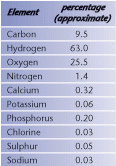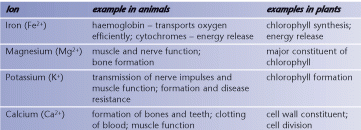Essential Substances
Substances required for living processes
Living things are based on a total of 16 elements out of the 92 which exist on Earth. Over 99% of the biomass of organisms is composed of just 4 key elements, carbon, hydrogen, oxygen, and nitrogen.
Carbon is the most important element because of its following properties:
- carbon atoms bond with each other in long chains
- the chains can be branched or even joined up as rings
- the carbon atoms bond with other important elements like hydrogen, oxygen, nitrogen, sulphur, calcium and phosphorus.
The linking of carbon to carbon in long chains forms the backbone of important structural molecules. Electrons not used in the bonding of carbon to carbon are shared with other elements, like hydrogen, oxygen and nitrogen. All the essential elements together have incredible properties contributing to the diversity of life forms on Earth.
The table below shows a range of elements found in the human body.

Some important elements
The molecules of every organism consist of a number of elements which bond together, and are vital to life. The properties of these inter-linking elements contribute to both structure and life processes.
Sodium atoms and chlorine atoms would be very destructive to life! Their properties would kill cells. However, in the form of ions they are vital to the survival of an organism. Inorganic ions are needed by organisms for a range of functions.


